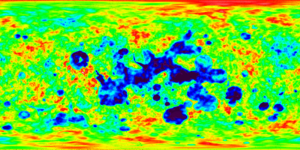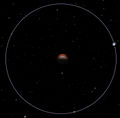Duna/ko
듀나(Duna)는 커볼계의 네번째 행성입니다. 커발 스페이스 프로그램에서는 지구의 화성과 비슷한 행성이고, 대부분 붉은색에 극점은 얼음으로 덮혀 있습니다. 듀나는 자연적으로 생성된 위성인 아이크를 가지고 있습니다. 아이크가 듀나와 가깝고 크기가 작기 때문에, 서로의 인력을 벗어날 수 없습니다.
적절한 공력제동을 수행한다면, 커빈 궤도에서 듀나의 궤도에 진입해서 다시 돌아오는 데에는 대략 1700m/s의 델타-V(delta-V)가 소모되게 되고, 이는 다른 행성으로의 편도 비행보다도 적은 수치입니다. 또한 듀나의 궤도 경사각이 작기 때문에 중력권에 진입하는 것도 가장 쉬운 행성입니다.
Contents
지형
듀나의 지형은 가장 낮은곳의 23m 부터 가장 높은 곳인 4740m 사이의 고도를 가지고 있습니다. 듀나의 산맥 지형 근처에 착륙하는것은 매우 위험한 일이며, 특히 대기가 매우 얇기 때문에 아주 약간의 속력만이 대기와의 마찰로 인해 감속될 수 있습니다. 하지만 얇은 대기 때문에 듀나의 극점에 있는 얼음지형은 꽤 넓습니다.
듀나에는 몇몇 크레이터가 존재하지만, 바람으로 인해 많이 침식된 것으로 추측됩니다.
또한 정확히 고도 0m 지점에는 몇개의 바다 (어둡게 보이는 넓은 부분)가 존재합니다. 이 지형은 평탄하고 고도가 낮기 때문에 좀더 많이 감속할 수 있어서 착륙하기에 쉽지만 착륙하기에는 따분한 장소입니다.
듀나의 표면에는 숨겨진 비밀들이 존재합니다.
대기
듀나의 대기는 대략 41,446 m에서 시작됩니다. 대기의 밀도는 고도 0 m 에서 비교했을때 커빈의 대기밀도의 20%밖에 안되고, 이는 커빈의 고고도에서의 밀도보다 더 작은 수치입니다. 이런 현상은 높은 지형에서는 더욱 심해져, 고도 0 m 에서의 21%밖에 되지 않습니다.(커빈과 비교하자면, 커빈에서 가장 대기의 밀도가 높은 곳에서의 밀도는 고도 0 m의 밀도보다 45% 두껍습니다.) 이렇게 대기의 밀도가 낮은것은 낙하산이 훨씬 낮은 고도에서 준-전개(Semi-Deploy)되게 하고, Mk25 낙하산의 경우는 10 km 정도에서 그리고 나머지 낙하산들은 9 km 이하에서 준-전개 됩니다.
착륙
When landing on Duna, aerobraking can reduce orbital and surface velocity greatly, saving fuel. For best results, an aerobraking maneuver should maximize time spent in the atmosphere by entering at a shallow angle and aiming for a landing location in a low-lying area.
Like all atmospheres in the game, Duna's atmosphere fades exponentially with increasing altitude (with a scale height of 3000 m). In general, the atmospheric pressure on Duna at an altitude expressed in meters is:[1]
Parachutes work at lower efficiency than on Kerbin, making powered descent necessary when landing from orbit (unless you have enough drag/parachutes).
Flying
The atmosphere of Duna might be thin, but on heights below 5 km it is thick enough that wings can generate enough lift to make aerodynamic flight possible. Jet engines don't work due to lack of oxygen, but other propulsion methods work well. Performing a horizontal landing with a plane is also possible.
Starting
An ascent to Low Duna Orbit from the surface typically requires around 1500 to 2000 m/s in Delta-V, leaving you in an orbit at 42km altitude traveling at roughly 950 m/s.
The following table gives terminal velocities at different Duna altitudes. These are also the velocities at which a ship should travel for a fuel-optimal ascent from Duna, given the game's model of atmospheric drag.[2]
| Altitude (m) | Velocity (m/s) |
|---|---|
| 0 | 212 |
| 1000 | 231 |
| 2000 | 252 |
| 3000 | 274 |
| 5000 | 324 |
| 8000 | 418 |
| 10000 | 495 |
| 13000 | 638 |
| 15000 | 756 |
| 20000 | 1.16×103 |
Tracking Station Info
Also known as the red dot that you can see if you squint really hard, Duna has long been a wonder to Kerbalkind. The planet has been held in much awe, due to its striking red color and stark contrast to the color green.
Orbital Statistics
The geosynchronous orbit of Duna is at an altitude of 0.00 미터 above Duna. The speed of the satellite is 0.00 미터/초 and it has an orbital period resonating with 1 Duna day (18.2 hours or 65517.859375 seconds). However, this is the same altitude at which Ike orbits, so unless a ship's orbit is perfectly precise, it will eventually be captured by Ike.
For a semi-synchronous orbit of ½ Duna day (9.1 hours or 32758.9295 seconds) an orbit of 0.00 미터 above Duna is needed with a velocity of 0.00 미터/초.
Observation of Ike
Ike's orbit keeps it directly above a short range of Duna longitudes. The average Duna longitude where Ike tends to stay directly above in the sky (at the Zenith) is 6 degrees east, but the exact longitude oscillates between about 2 degrees and 10 degrees east due to the eccentricity of Ike's orbit. This eccentricity also makes Ike appear to grow slightly larger and smaller to an observer on the surface of Duna. The latitude for which Ike is in the Zenith also oscillates between 0.2 degrees south and 0.2 degrees north due to Ike's orbital inclination, making Ike appear to rotate upwards and downwards as viewed from the surface, but due to the extremely small orbital inclination, this effect is nearly imperceptible. These phenomena together are known as libration. Due to the oscillation in Ike's position above the horizon, areas from 88°W to 80°W and 92°E to 100°E on Duna can observe Ike rise and set at least partially across the horizon, as can any areas north of 89.8°N or south of 89.8°S.
Interplanetary Travel
From altitude orbit around Duna, the amount of delta-V needed to reach the orbits of other celestials is as follows:
| Body | Delta-V | |
|---|---|---|
| Ike | ~300 m/s | |
| Kerbin | ~620 m/s | |
| Dres | ~820 m/s | |
| Eve | ~1080 m/s | |
| Jool | ~1350 m/s | |
| Eeloo | ~1580 m/s | |
| Moho | ~2100 m/s | |
Reference Frames
| 시간 배속 | 최저 고도 |
|---|---|
| 1× | 어디서든지 |
| 5× | 50 000 미터 (대기 바깥에서) |
| 10× | 50 000 미터 (대기 바깥에서) |
| 50× | 60 000 미터 |
| 100× | 100 000 미터 |
| 1 000× | 300 000 미터 |
| 10 000× | 600 000 미터 |
| 100 000× | 800 000 미터 |
Gallery
Duna at sunrise
Changes
- Minor art pass
- Initial Release
Trivia
- Duna's name may be either a reference to its desert landscape or a shout-out to the Frank Herbert novel Dune.
- The low-lying areas near Duna's equator make a shape resembling Europe.
- On the surface of Duna, there is a large monument carved in the likeness of a Kerbal face, alluding to the infamous "Face of Mars" discovered in the Cydonia Mensae region of Mars during the 1970's.
- Buried deep under the surface, there is a small camera, similar to the design on the Pathfinder rover.
- One anomalous feature on Duna is a small, pyramid-like hill emitting an SSTV signal. When decrypted, it shows a diagram-like image of three figures standing next to the hill itself, implying that Duna was once inhabited or visited before.
Notes
- ↑ A nuclear engine has a specific impulse of 220 in 1 atm, 800 in vacuum, and the following at various Duna altitudes:
altitude (m) 2 100 300 500 1460 2420 3000 4272 5000 10000 specific impulse 684.1 687.8 695.1 701.8 728.7 748.2 757.3 772.1 778.1 795.9 - ↑ http://forum.kerbalspaceprogram.com/showthread.php/6664-Mini-challenge-max-altitude-with-this-supplied-spacecraft?p=100912&viewfull=1#post100912











